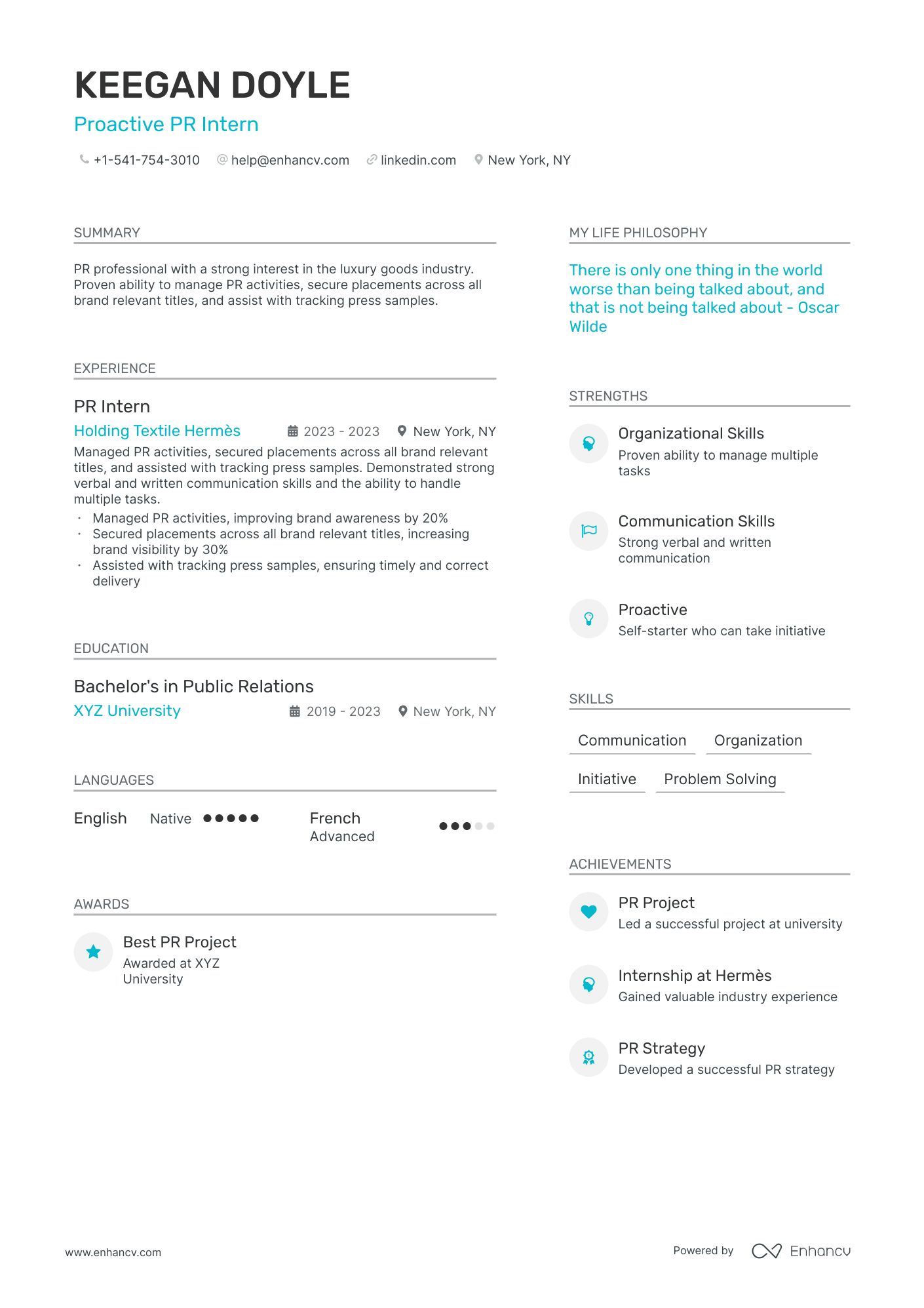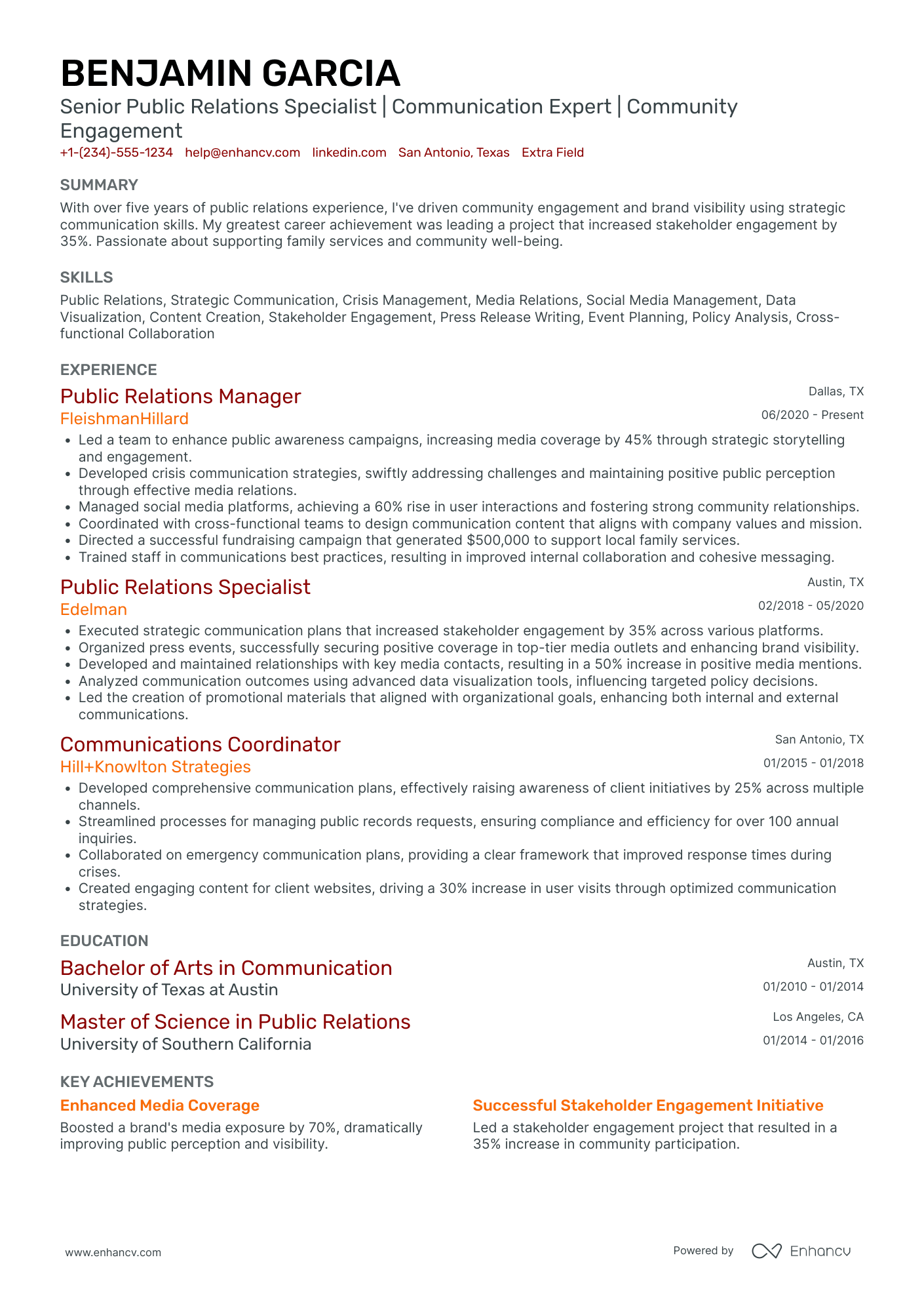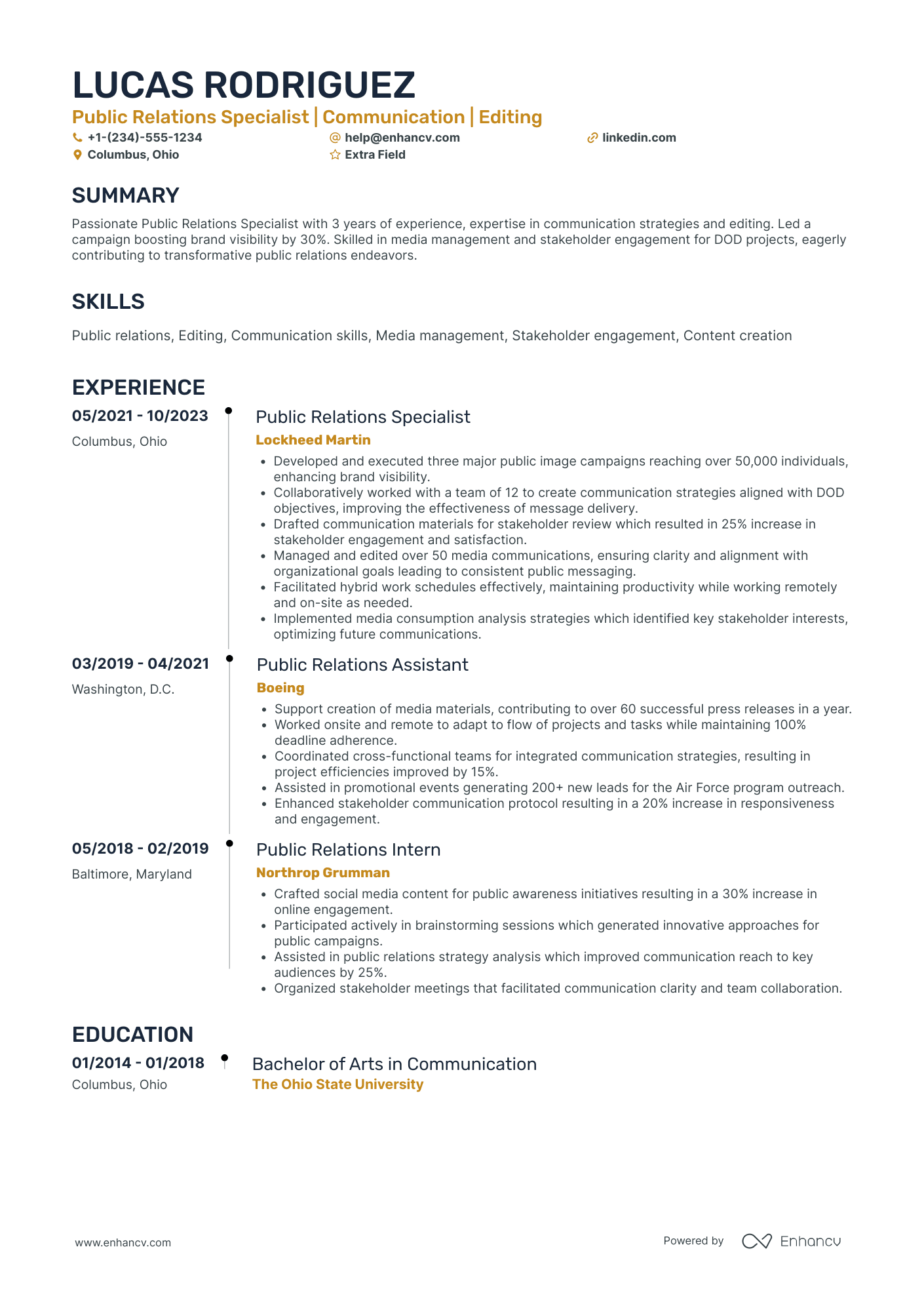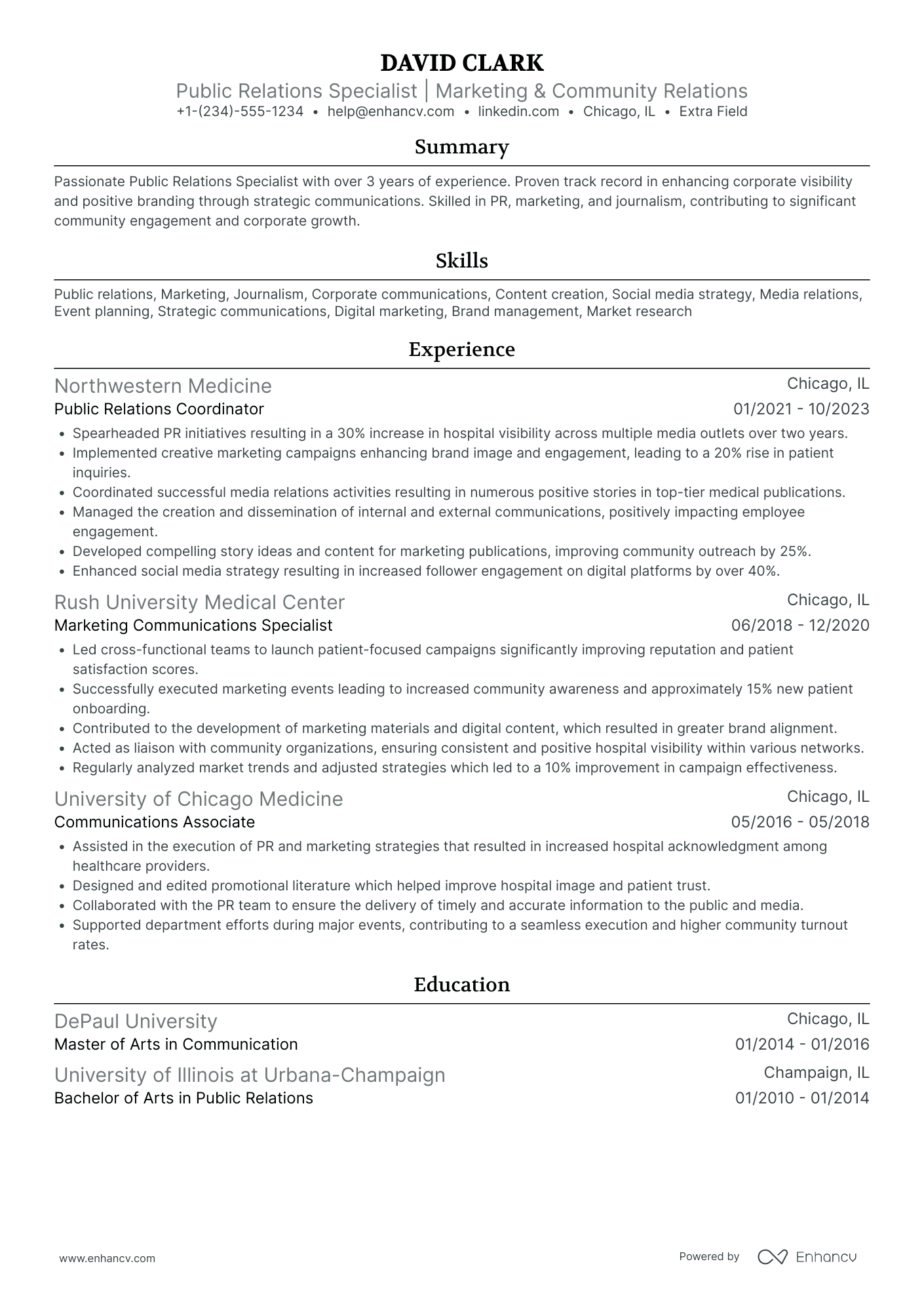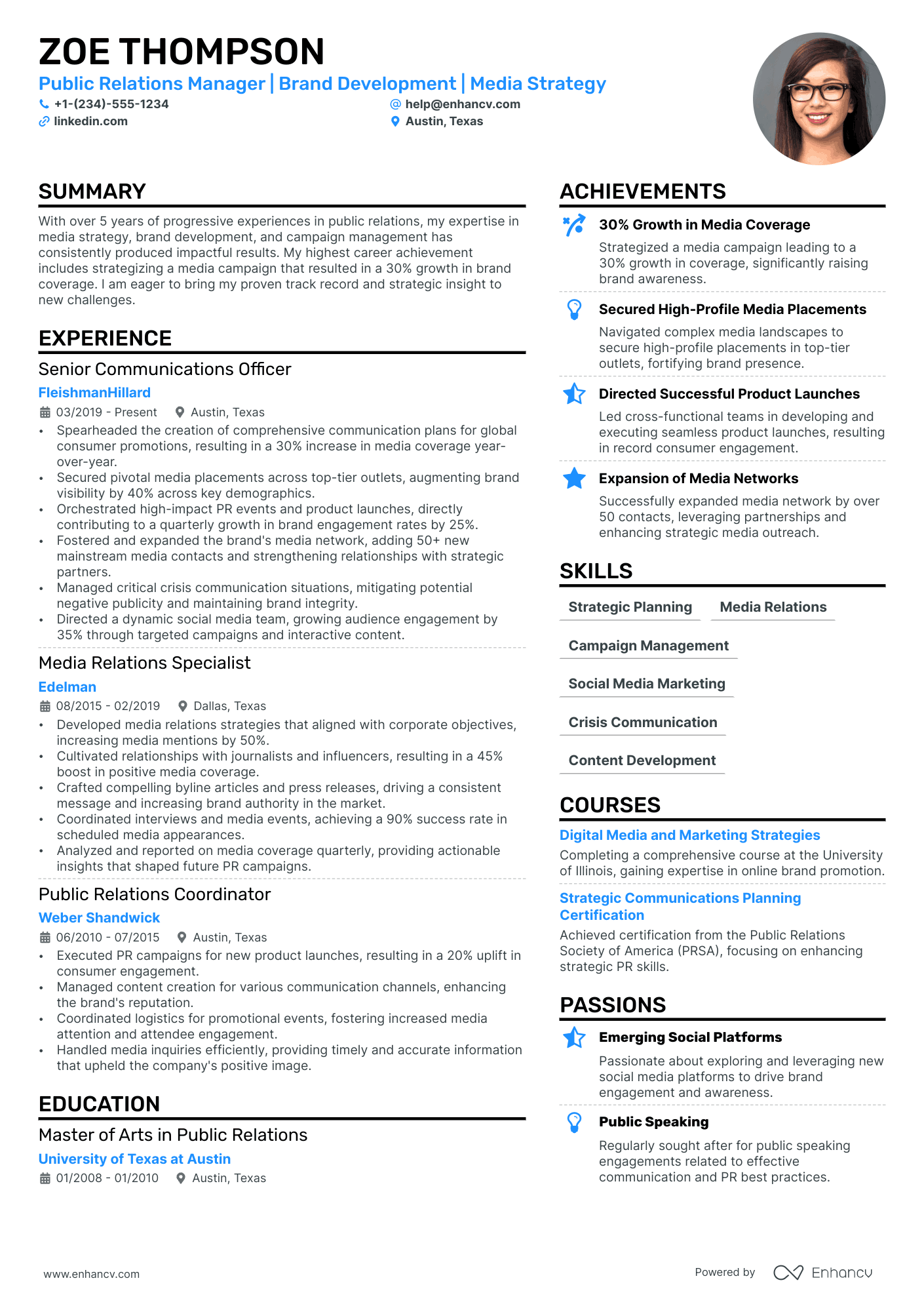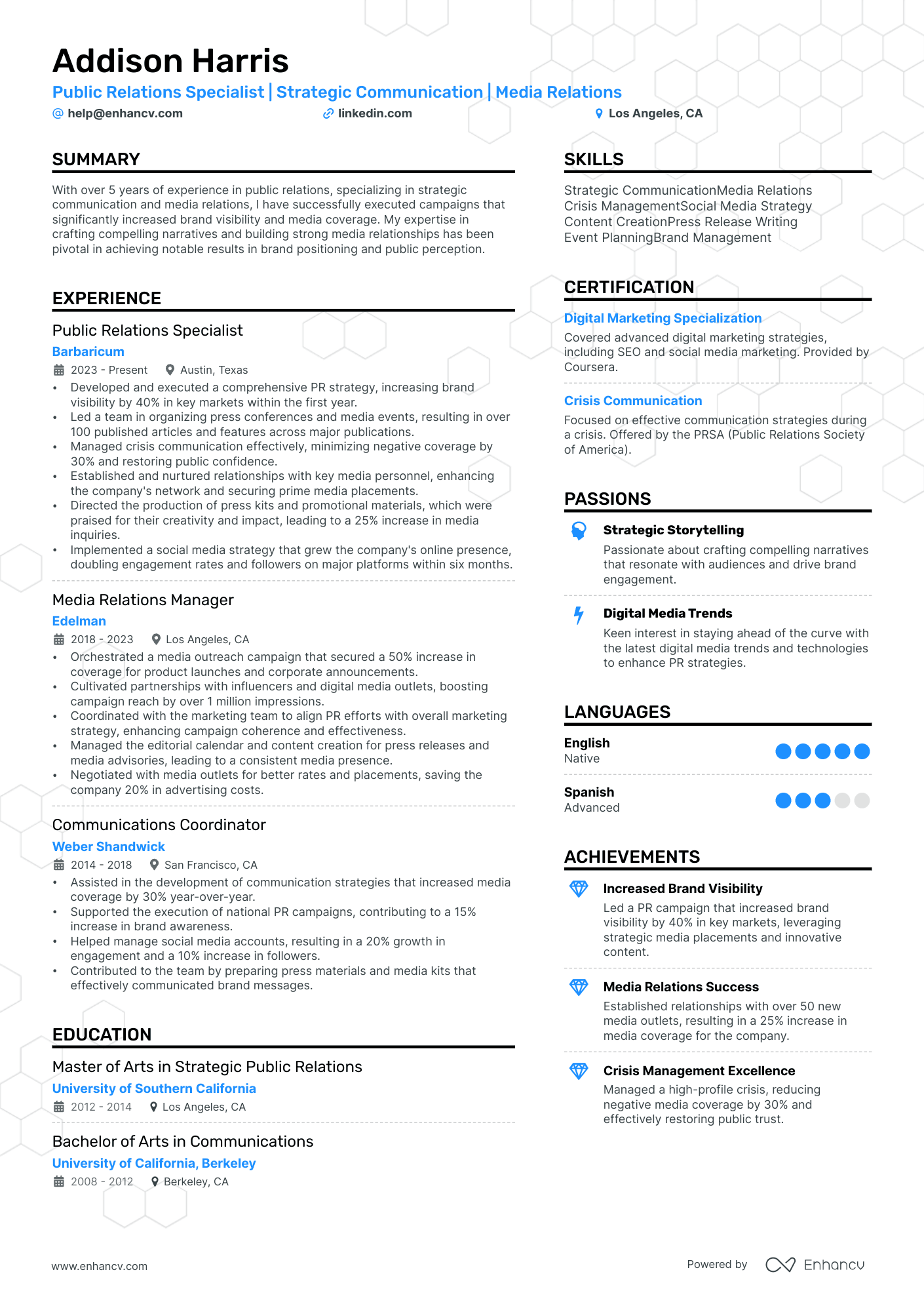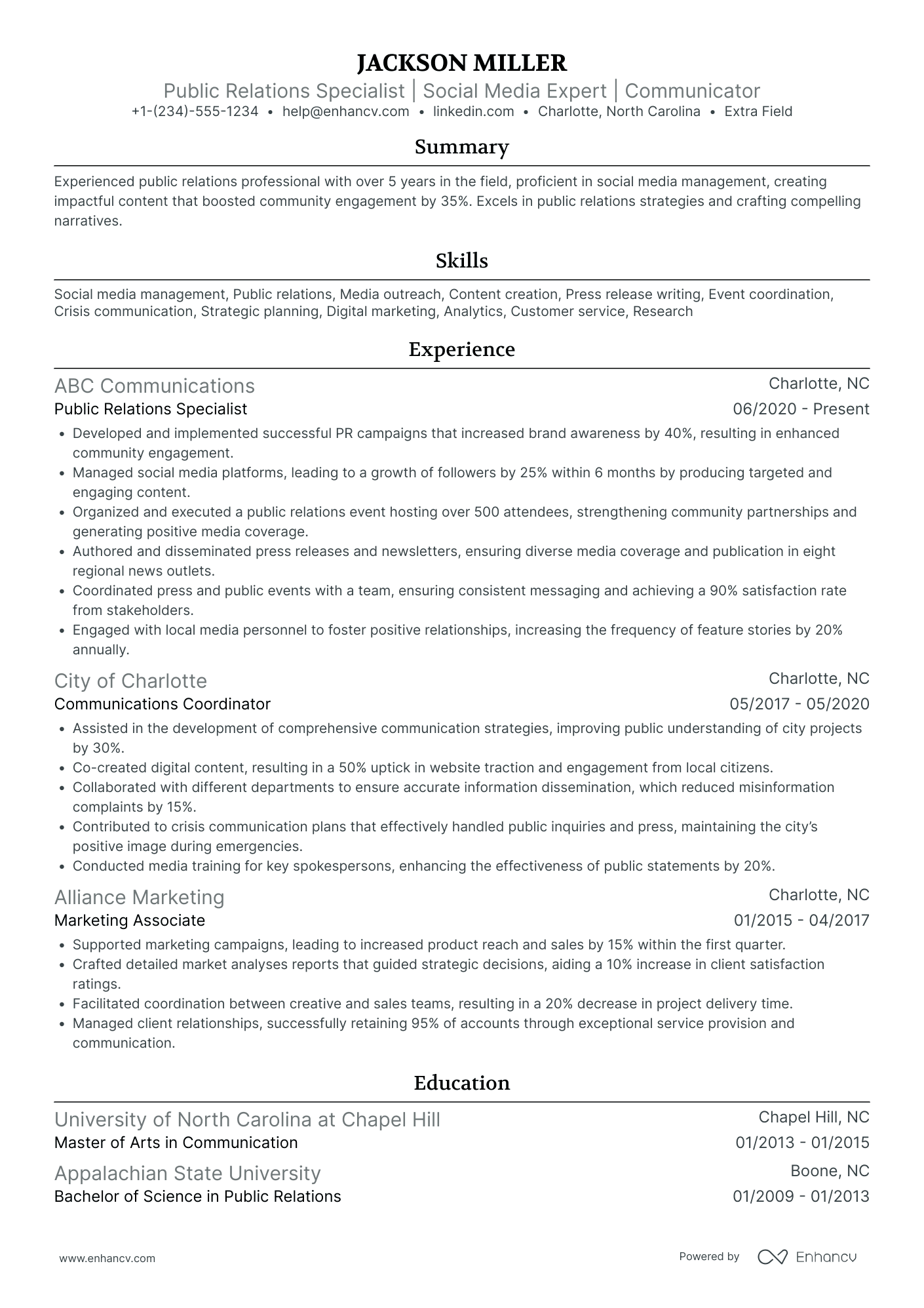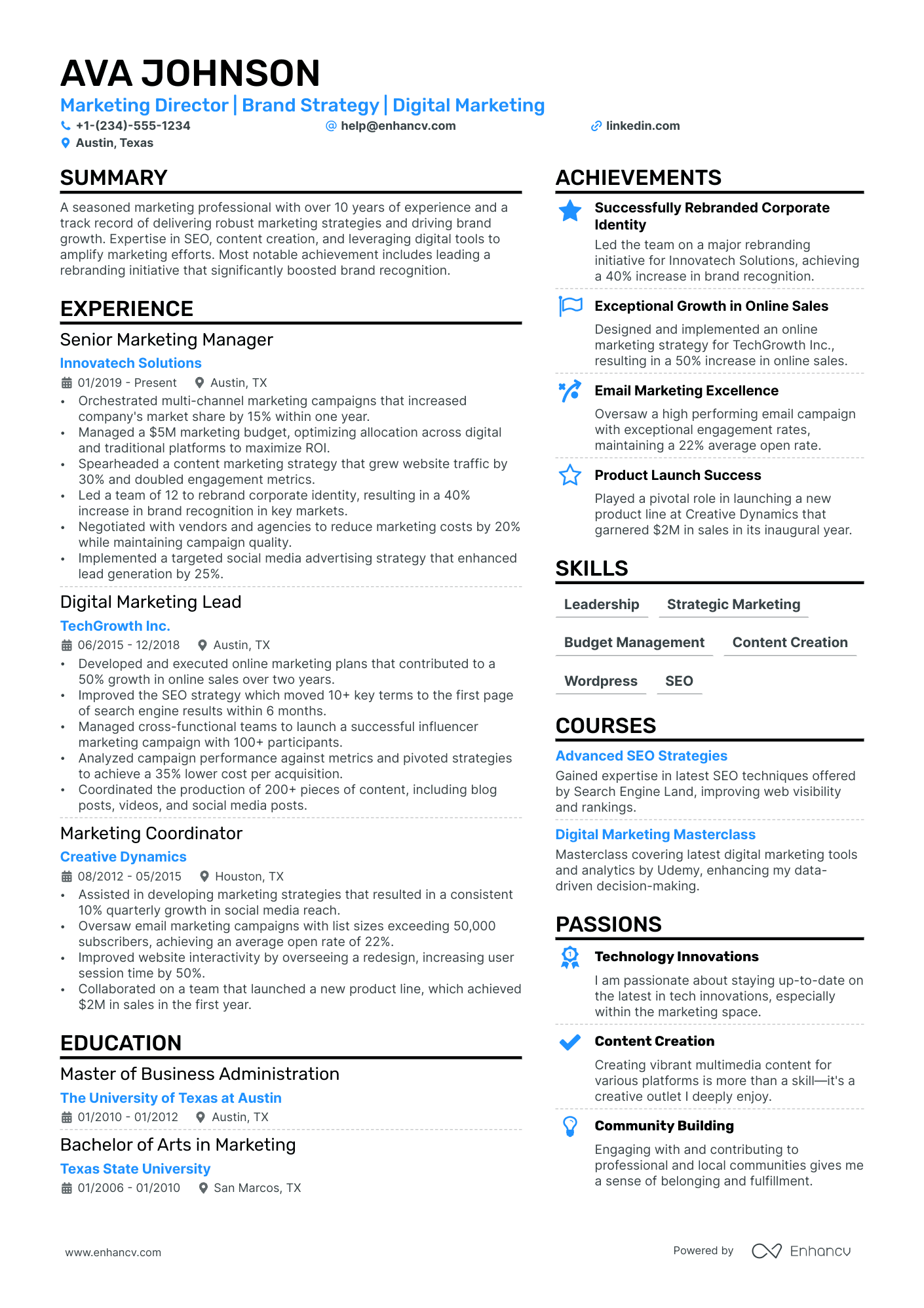Public relations is all about getting people to see things your way. If you're a public relations specialist, you know how to grab an audience's attention.
So, making a killer resume should be easy for you, right? You already know how to win hearts and minds. But let's face it, standing out today is tougher than ever. Everyone's bombarded with messages 24/7.
Your PR specialist resume needs to show you're not just another voice in the crowd. You know how to make a real splash.
That's where our guide comes in. We've put together a no-fluff guide to help you shine.
Here's a sneak peek at what our public relations specialist resume guide will teach you:
- Pick the best resume format and sections that showcase your skills and wins;
- Impress employers with an experience section that speaks volumes;
- Strategically spotlight your PR skills, proving you're a master at navigating the media landscape and engaging audiences;
- Craft a compelling public relations specialist summary that gets recruiters hooked.
Craving more expert tips for industry-specific resumes? Dive into our treasure trove of insider guides:
- Marketing resume
- Marketing specialist resume
- Brand manager resume
- Brand marketing resume
- Public relations specialist cover letter
Public relations specialist resume example
Here’s what this applicant does well in their resume:
- Strategic communication and media relations experience. The candidate highlights their skills in strategic communication and media relations, showing off successful campaigns that boosted brand visibility and media attention. This is key for a public relations specialist who wants to prove their talent in creating engaging stories and building solid media connections.
- Quantifiable achievements. They share clear results like boosting brand visibility by 40%, doubling social media engagement, and getting 50% more media coverage for product launches. This shows their real impact and success in past jobs.
- Relevant education and certification. They mention having a Master's in Strategic Public Relations and certificates in Digital Marketing and Crisis Communication, which match the job's needs. This highlights their dedication to growing their skills in PR.
Looking to achieve the same? In the next few sections, we'll dive into how essential skills can be seamlessly woven into the right resume format.
How to format a public relations specialist resume
If you've got the PR chops, a reverse chronological resume is your best bet. Why? Because it puts your experience front and center, right where hiring managers want to see it.
This resume layout is best for showcasing a solid track record in public relations or any related field.
But what if you're just starting or your path in PR has taken a few twists and turns? Then, a hybrid resume might be the way to go, especially for junior-level roles. The hybrid, also known as a combination resume lets you show off both what you know and what you've done, giving a full picture of your talents and potential.
Finally, when deciding on a resume format, remember the following:
- Double-check your resume for errors and consider using a spell-checking tool.
- Keep your resume to a maximum of 2 pages and leave enough blank space for readability.
- Save your PR specialist resume as a PDF file to ensure it can be opened and viewed on any device.
- Opt for a resume layout that will help you nail the header. (You can’t make a first impression twice, right).
Each market has its own resume standards – a Canadian resume layout may differ, for example.
Is your resume good enough?
Drop your resume here or choose a file. PDF & DOCX only. Max 2MB file size.
To sum up, below are the most important sections to work on when building your PR specialist resume.
The top sections on a public relations specialist resume
- Professional summary: This section provides a brief overview of your skills, experiences, and accomplishments in public relations, which makes it easier for recruiters to understand your qualifications at a glance.
- Core skills: Listing your skills like media relations, crisis management, and brand development can showcase your expertise in key areas of public relations. This may increase your chances of being selected for an interview.
- Work experience: This section shows your previous roles and responsibilities as a public relations specialist.
- Achievements: In this section, you can mention specific campaigns or projects you have handled successfully. This would demonstrate your effectiveness in the role and can set you apart from other candidates.
- Education/Professional training: It's essential to highlight your educational background and any specific training in public relations to underline your academic qualifications and professional development in the field.
Now that we have the top sections to feature on your PR resume, think about the impact you can make on recruiters by prioritizing key strengths and skills. Below are some examples:
What recruiters want to see on your resume
- Media relations expertise: Recruiters prioritize this because a major part of public relations involves effectively communicating with media outlets and personalities to promote or protect a company's image.
- Crisis management skills: This is crucial as PR specialists often have to manage unexpected situations or crises and ensure they are handled professionally to protect the company's reputation.
- Excellent communication skills: PR specialists need to interact with multiple stakeholders including media, public, and clients. Recruiters look for actual proof you’re a good communicator, not simply stating the obvious.
- Experience with social media and digital platforms: Recruiters prioritize this as PR specialists often need to manage digital campaigns and online reputation. Experience in these channels is indicative of a candidate's ability to navigate the modern PR landscape.
- Track record of successful PR campaigns: Recruiters seek candidates with a proven history of success as it indicates the candidate's ability to achieve positive results and handle the responsibilities of the role efficiently.
Now, let’s get into the nitty-gritty of crafting the most eye-catching part of your resume, the experience section.
How to write a public relations resume experience
The experience section of your PR specialist resume is like a gold mine of opportunity. Here's how to dig in:
- Pick and choose the roles you mention to match the job you want. You don't need to list every single job, just the ones that matter for the role you're eyeing.
- Use the same wording from the job ad wherever you can. This isn't just smart — it's also a nod to those pesky applicant tracking systems (ATS).
- Throw in some numbers to back up your achievements. We get it, PR wins aren't always easy to measure, but there's gotta be some impressive stats you can highlight. Don’t miss the How to quantify the impact on your resume section below.
We’re presenting two examples to illustrate the do’s and don’ts of writing about your employment history.
- •Liaised with key media.
- •Created PR strategy to increase positive media coverage.
- •Developed a crisis management plan for one of our clients.
- •Measured PR metrics and performance.
Let’s break down why this doesn’t work.
- Mistake #1. “PR specialist” looks taken from a laundry list of jobs. It’s far too generic and lacks distinction.
- Mistake #2. No workplace description. This is a missed chance. Including details about the company could have provided depth and context to the candidate's experience.
- Mistake #3. The bullet points offer flat descriptions of duties rather than highlighting the candidate's accomplishments and the tangible impact of their work.
Now, let's see how a few simple changes can significantly enhance this.
- •Liaised with over 50 key media outlets, resulting in a 30% increase in brand mentions across major publications.
- •Created a PR strategy that boosted positive media coverage by 45%, reaching an audience of over 5 million across multiple platforms.
- •Developed a comprehensive crisis management plan for one of our top clients, mitigating potential negative coverage by 90% and restoring public confidence.
- •Measured PR metrics and performance, identifying a 60% improvement in engagement rates and a doubling of media impressions within the first quarter.
- Workplace description — effectively detailed.
- Position — defined in full.
- Responsibilities and achievements — thoughtfully quantified with data.
Note how the inclusion of specific metrics transforms how we view the candidate, signaling a seasoned professional's profile.
Moreover, the strategic use of impactful words such as “increase”, “boost”, “top”, “positive”, “improvement”, and “doubling” cleverly influences perception, even on a subconscious level.
But how do you create a balanced and quantified experience section? Public relations specialists often struggle to quantify their professional achievements.
We can help with that. Read on.
How to quantify impact on your resume
You’re great with words and you know it. Now let’s get you better at numbers.
To amplify your professional impact, try to follow these simple steps:
- Include the number of social media followers you helped increase. This indicates your ability to build strong online presence and visibility.
- Specify the percentage by which you improved positive media coverage. This shows your capability in managing press relationships and promoting the company's positive image.
- Quantify the number of crises you have managed to demonstrate your experience in handling difficulties and protecting the company’s reputation.
- Highlight the reach of campaigns you conducted in numbers. It showcases the scale at which you can operate and the impact you can deliver.
- Mention the percentage increase in overall brand recognition during your tenure. This points towards your effectiveness in raising public awareness of the brand.
- Note down the number of unique PR strategies you devised. This showcases your innovative thinking and strategic planning skills.
- Present the number of key industry influencers you have relationships with. This sheds light on your network and ability to tap into powerful channels for brand promotion.
- State the number of employees you trained in media handling. It shows your leadership and mentorship ability, and contribution towards making the company PR-ready.
So far, so good. But what if you’re just about to land your first job in public relations?
How to write a public relations specialist resume with no experience
Whether you're eyeing an internship, an entry-level position, or just looking to switch industries, chances are you're beginning with minimal experience.
Picture this: you come from a sports PR background and apply to a tech-centric company. You might find yourself struggling to respond to detailed inquiries. This is where showing your passion for the field becomes crucial, and, yet again, bringing metrics into the conversation can bolster your case.
Here are some smart strategies for crafting your entry-level PR specialist resume:
- Speak the language of PR. Demonstrating familiarity with PR jargon can convincingly show recruiters you're in the know. Strategically sprinkle industry terms throughout your resume, especially in the experience and summary sections.
- Customize your resume. Seize every chance to spotlight your skills over your experience shortfall. Flesh out the skills section, and don't hesitate to include educational honors and certifications that underscore your dedication to advancing in the PR world.
- Highlight relevant experiences that have honed your PR abilities, whether that's managing a social media profile, utilizing analytics tools, or coordinating community gatherings.
Now let’s dive into personalizing your skills section, as it is equally important for both junior and senior PR positions.
How to list hard and soft skills on your resume
When detailing skills on your PR specialist resume, authenticity is key. Claiming proficiency in APA style or crisis management without concrete evidence will hardly impress.
Aim to add tangible examples that showcase your abilities. Whether woven into the experience or summary sections or spotlighted in a dedicated "Proudest Moments" or "Career Highlights" section on your resume's sidebar, real-world illustrations of your skills make a stronger impact.
Neglecting to list skills could mean an untimely exit, courtesy of ATS. Big organizations often use these systems to sift through resumes based on the skills mentioned in the job ad.
When it comes to showcasing soft skills, PR specialists often boast a wide range of such skills. However, these can be challenging to communicate effectively on paper. Rather than listing every skill you possess, focus on those you truly excel in and offer concrete examples of how you've applied them in real-world situations.
Here’s a list of some you can use.
Best soft skills for a public relations resume
- Interpersonal skills
- Communication skills
- Creativity
- Empathy
- Adaptability
- Problem solving
- Decision making
- Multitasking
- Stress management
- Leadership
- Time management
- Negotiation
- Teamwork
- Detail-oriented
- Assertiveness
- Conflict resolution
- Networking
- Responsiveness
- Patience
- Persuasion
Regarding hard skills, this includes all the tools and software essential for your work as a PR specialist, along with practical abilities. Choose your strongest skills from the list below and be sure to include specifics.
Best hard skills for a public relations resume
- Media relations
- Public speaking
- Crisis management
- Press release writing
- Social media management
- SEO and SEM
- Brand development
- Copywriting
- Event planning
- Content creation
- Digital marketing
- Adobe Creative Suite
- Google Analytics
- Email marketing platforms
- Media monitoring tools
- Media database management
- Data analysis
- HTML and CSS
- PPC advertising
- Video production
If you feel that doesn't fully capture your professional essence, consider adding a section on your resume's sidebar for your certifications. This can be particularly savvy, especially if you're just beginning your career in public relations.
Let’s get to it.
How to list certifications and education on your resume
In the world of Public Relations, hands-on experience often takes the spotlight. As you dive deeper into your PR career, practical skills tend to overshadow your educational background. Yet, for those fresh out of college, your education remains a beacon on your resume.
When filling out the education section, don't just list your degree. Make it shine by including
- Your major or field of study;
- Your GPA, but only if it's above a 3.2;
- Any standout achievements, like student awards or projects that made it into the media.
Here’s the deal. Among the 21,000 members of the Public Relations Society of America, only 23 % boast an APR (Accredited in Public Relations) certification. If you're one of those people, make sure it's prominently featured on your resume. This highlights your grasp of key industry standards, including research, evaluation, implementation, and ethics.
Here are the top certifications to consider including in your resume.
Best certifications for your public relations resume
- Strategic Communication Management Professional (SCMP)
- Certified Communications Professional (CCP)
- Advanced Certificate in Public Relations
- Digital Communication Certificate
Now onto the most attention-grabbing part of your PR resume – the summary.
How to write a public relations resume summary or objective
Imagine you're on the receiving end of your press release. You'd do everything to make sure your pitch stands head and shoulders above the rest, right?
That's exactly how you should approach your resume. It should compellingly tell your story.
Do the opening lines grab attention? Do they succinctly communicate why someone should take notice immediately?
This is precisely what your career summary or objective should achieve. Within a few brief sentences, your goal is to convey who you are professionally and why you're the ideal fit for the position.
So, which should you opt for: a career summary or an objective?
- A career summary showcases your overall accomplishments and journey in the PR field, making it an excellent choice for seasoned PR specialists or those eyeing executive roles. An effective summary shines a light on your standout achievements, framing them with quantifiable data for added impact.
- A career objective zeroes in on your existing skills and your eagerness to contribute these to the prospective employer. It's most suitable for newcomers to the field or those looking to pivot into PR. When drafting a career objective, highlight your skillset and deliver a strong statement of who you are.
Now's the time to translate this theory into action.
Here’s why this summary doesn’t do the candidate any justice.
- Lacks specific achievements: The summary fails to mention any quantifiable results or specific accomplishments, making it hard to gauge the candidate's impact in previous roles.
- Vague skill descriptions: The mention of "familiar with analytics and SEO" is too broad and doesn't demonstrate expertise or successful application of these skills in past projects.
- Unclear career goal: Stating an interest in applying skills in a new setting does not convey a clear career goal or how the candidate plans to contribute to the company.
- Generic use of language: The summary should be an irresistible pitch, but this example reads like it was generated by AI. It lacks the personalized touch and compelling language that grabs attention and distinguishes the candidate from others.
Let’s see how this can be revamped to hook the recruiter.
You immediately see why this version stands a better chance of being noticed.
- Quantifiable achievements: By providing specific numbers, such as a “150% increase in web traffic” and “doubling social media engagement”, the summary demonstrates the candidate's ability to deliver impactful results.
- Focused expertise: The summary showcases specialized skills in tech PR, analytics, SEO, and social media strategy, positioning the candidate as an expert in technology communications and making them highly relevant for roles in this niche.
- Clear value proposition: The candidate expresses a strong desire to apply their skills to drive growth and enhance the company's market presence.
- Engaging personal touch: Using the first-person narrative sets a compelling scene for the resume, engaging the reader right from the start rather than merely listing facts.
Much better, right? How can we take it from good to great? By sprinkling in your standout PR achievements (we know you have them) to truly impress your audience – the recruiters.
Additional sections for a public relations resume
The perfect spot for showcasing your awards and achievements on your PR specialist resume is right where it catches the eye. Don't hold back; let them shine! Here's how you can make them pop:
- Place the awards section in the sidebar and play with contrasting colors. Colors naturally draw the eye and can effectively highlight this area.
- Use icons before each achievement to add visual interest and enrich the context. Icons serve as engaging markers that guide the reader's attention.
- Keep it brief yet detailed. When listing awards, include pertinent dates and the awarding institutions. If you're highlighting a specific achievement, be sure to explain its significance.
These simple strategies ensure your accolades are both noticed and appreciated, providing a clear picture of your accomplishments.
PRO TIP
Feel free to play around with a resume builder to create a resume that really captures your strengths.
Key takeaways
In the world of PR, if you're not telling a story that sticks, you're probably just adding to the noise. Let's face it, crafting a resume that reads more like an unforgettable pitch than a dry list of duties is what separates the pros from the amateurs.
Here are the key takeaways to ensure your resume doesn't end up in the 'read later' pile:
- Pitch-perfect presentation: Your PR specialist resume should captivate like a well-crafted pitch, highlighting your achievements with clarity and impact.
- Strategic formatting: Choose a resume format and layout that showcases your work history in the best light, making it easy for hiring managers to see your career narrative.
- Measurable success: Incorporate quantifiable impact wherever possible to demonstrate the tangible value you've brought to previous roles.
- Spotlight on achievements: Don't bury your awards and accolades; give them a prominent place on your resume to shine, proving your work doesn't just talk the talk but walks the walk.
Remember, in the world of Public Relations, your resume is your first campaign. Make it count!
Public Relations Specialist resume examples
By Experience
PR Intern
Senior Public Relations Specialist
Experienced Public Relations Specialist
Junior Public Relations Specialist
Entry-Level Public Relations Specialist
By Role
